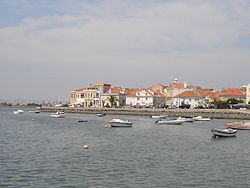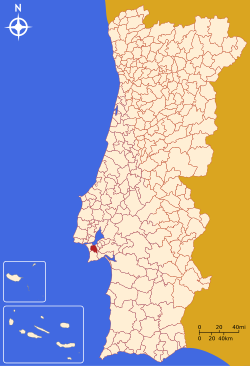Seixal
| Seixal | |||
|---|---|---|---|
| Municipality | |||

A view of the edge of the Bay of Seixal
|
|||
|
|||
 |
|||
| Coordinates: 38°39′N 9°06′W / 38.650°N 9.100°WCoordinates: 38°39′N 9°06′W / 38.650°N 9.100°W | |||
| Country |
|
||
| Region | Lisbon | ||
| Subregion | Península de Setúbal | ||
| Metropolitan area | Lisbon | ||
| District | Setúbal | ||
| Parishes | 4 | ||
| Government | |||
| • President | Joaquim Santos (CDU) | ||
| Area | |||
| • Total | 95.50 km2 (36.87 sq mi) | ||
| Population (2011) | |||
| • Total | 184,269 | ||
| • Density | 1,900/km2 (5,000/sq mi) | ||
| Time zone | WET/WEST (UTC+0/+1) | ||
| Website | http://www.cm-seixal.pt | ||
Seixal (Portuguese pronunciation: [sɐjˈʃaɫ]) is a Portuguese municipality, located in the district of Setúbal, in the region of Lisbon. Its population includes 184,269 inhabitants (2011), situated across the Tagus River estuary from Lisbon, in an area of 93.58 square kilometres (36.13 sq mi) that includes six parishes. Its seat is the city of Seixal a centre of 31,600 inhabitants situated along the Rio Judeu.
The present Mayor is Joaquim Santos, elected by the Unitarian Democratic Coalition since September 2013. Seixal is known for being one of the few cities in Portugal under the power of the communist party for more than 20 years.
The toponymy Seixal comes from a type of smooth stone (seixo) that is found in rivers; the name evolving from the name used to describe the geomorphology of the region.
Since the Roman era, the Tagus bay has been a region of human settlement, from many of the archaeological discoveries at Quinta do Rouxinol, in Corroios, and Quinta de S. João, in Arrentela (beginning in the period of the Portuguese Age of Discovery). A land of fishermen and signeurial holdings, the municipality of Seixal evolved over the centuries, always with the connection to the river. It was across the Tagus that many of the region's products (fishe, cereals, salt, olive oil, wine and fruits) were exported to the regional capital.
In the 15th century, due to its prime location, various dockyards and shipbuilders began constructing river boats and trans-Atlantic ships. At the same time, the tides of the region were used to develop mills, such as the tidal mill in Corroios in 1403, fostering various the millers, caulkers and carpenters along the river. It was in Seixal that the brothers Vasco da Gama and Paulo da Gama built vessels for the trip to India. While Vasco da Gama was in Lisbon to prepare the trip, Paulo da Gama commanded carpenters and caulkers in the construction of the ships. Estevão da Gama, the father of the brothers, was commander of Seixal. The construction of the ships was the beginning of what is known as the Portuguese Discoveries. The settlement at this time was actually a part of the parish of Arrentela, then a division of Almada.
...
Wikipedia


